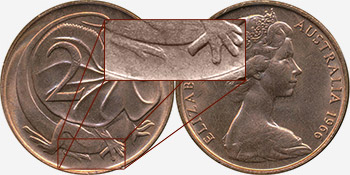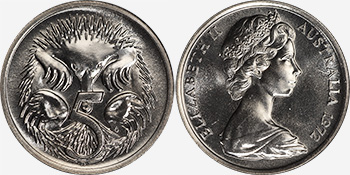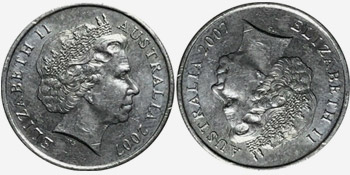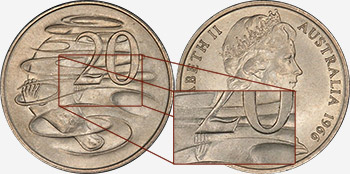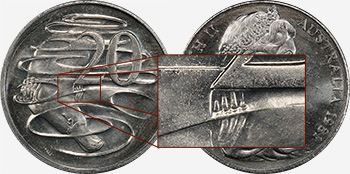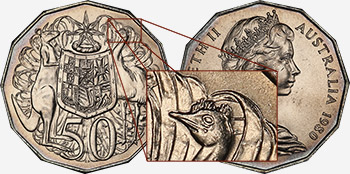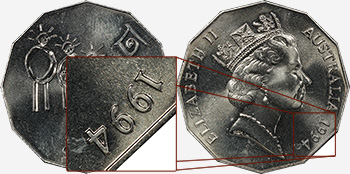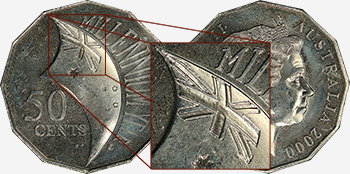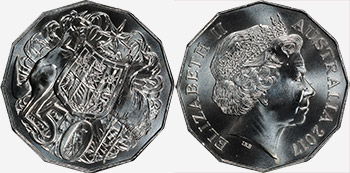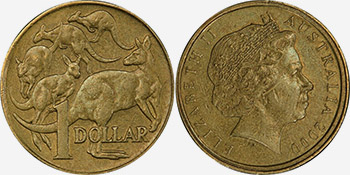Top 10 most known and desirable Australian modern errors and varieties
By CAA | Friday, 14 February 2020
Even if most decimal australian coins aren't worth much, some errors and varieties were discovered over time and became highly collected by many people. Here's the top 10 most known and desirable australian modern errors and varieties sorted by denomination and date:
2 cents 1966 to 1968 - Without SD
When decimalization details were discussed, Stuart Devlin was chosen to produce reverse designs based on australian wildlife with big numeral numbers representing the denomination. Devlin initials normally appear between the frilled lizard legs on two cent coins.
In 1966, 1967 and 1968, some of coins were struck without the SD initials. So far, PCGS certified only 14 of them in 1966 (Blunt 1st claw/Perth Mint variety), 62 in 1967 and 47 in 1968. In Mint State condition, these coins can fetch up $200 AUD to $400 AUD at auction.
Two cents 1966 to 1968 price guide and value »
5 cents 1972 - Low Echidna
Only 8.25 million 5 cents coins in 1972 (compared to 306.5 million in 2006). A smaller design of the Echidna on the reverse exists, also called Low Echidna. PCGS certified 524 High Echidna variety and 59 Low Echidna, which makes the second one rarer.
Both varieties have a premium price compared to most of the other 5 cents dates.
Five cents 1972 price guide and value »
5 cents 2007 - Double Head
This kind of error happens when two obverse dies are used to strike a coin. A lot of fakes exist of this kind of error, often created for magicians or sold in curiosity shops.
At an auction by International Auction Galleries in June 2019, a genuine example of this coin, certified PCGS MS-62, sold for $2,500 AUD. The same year, two other examples, PCGS AU-55 and AU-58, sold for $2,245 AUD and $2,963 AUD respectively.
Five cents 2007 price guide and value »
20 cents 1966 - Wavy 2
When the London Mint began to strike Australian coins for the new decimal system, a small number of twenty cents coins were struck with a reverse die containing a wavy baseline on the 2 of 20 cents. This is probably the most well-known decimal coin variety.
There are 111 PCGS certified examples and 3 NGC. Around 50% of these slabbed coins are in Mint State condition. Circulated, this variety is worth from $400 to $1,000 and it can bring $1,500 AUD to $5,000 AUD uncirculated.
Twenty cents 1966 price guide and value »
20 cents 1981 - 3½ claws - Scalloped letters
In 1981, a rarer variety exists showing only 3½ claws on the platypus.
This coin, when certified in MS grade, is worth between $100 AUD to $200 AUD.
Twenty cents 1981 price guide and value »
50 cents 1979 and 1980 - Double bar
Fairly common, this variety is a highly collectible coin even if it isn't worth much. It can be distinguished by looking at the back of the emu's head, second-largest living bird by height.
The value of this variety is generally the double of the original version.
Fifty cents 1979 and 1980 price guide and value »
50 cents 1994 - Family - Wide Date
This coin Celebrating the United Nations International Year of the Family was struck with two different obverse dates: narrow and wide. The spaces between the digits is the easiest way to recognize each variety.
This coin isn't worth much either, but both varieties have their spots in any decimal collection.
Fifty cents 1994 price guide and value »
50 cents 2000 - Millenium - Incuse Flag
In 2006, Drew Jackson, collector, found out that 2 varieties (raised and incuse flag) exist for the reverse of the 2000 50-cents commemorative millennium coin. The Royal Australian Mint estimated that 200,000 of this variety were struck for circulation from a single die.
Even if many examples are known, a high Mint State condition Incuse flag 50-cents coin is worth above $2,000.
Fifty cents 2000 price guide and value »
50 cents 2010 - 30 degrees rotation
In the Renniks Australian Pre-Decimal & Decimal coin errors book, released in 2015, only 8 examples of this coin were known.
It is currently easy to get one on Ebay for around $50 to $100. Even if it isn't worth thousands, this coin is one of the most known modern error on australian coins.
Fifty cents 2000 price guide and value »
1 dollar 2000 - Mule
Struck with 10 cents obverse die causing a double obverse rim. An employee, anonymously, said that the Royal Australian Mint wanted to destroy all mules when the mistake was found during the production process. Even if 462 PCGS and 13 NGC are certified, none are MS-65 or better. Current estimate of circulating one dollar 2000 Mule is 6,000 copies.
Recently, a MS-62 certified specimen sold for around $5,000 AUD on Ebay.
One dollar 2000 price guide and value »
Decimal coins price guide and values

